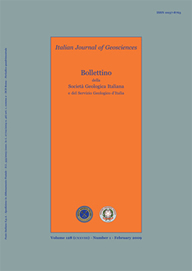
Testing the seismogenic sources of the January 11th 1693 Sicilian earthquake (Io X/XI): insights from macroseismic field simulations
F. Visini(*), R. De Nardis(**), M.S. Barbano(***) & G. Lavecchia(*)
(*) Laboratorio di Geodinamica e Sismogenesi, Dipartimento di Scienze della Terra, Università «G. d'Annunzio», Campus Universitario - 66013 Chieti Scalo, Italia - f.visini@unich.it
(**) Dipartimento della Protezione Civile, Roma.
(***) Dipartimento di Scienze Geologiche, Università di Catania, Corso Italia, 55 - 95129 Catania
Volume: 128 (2009) f.1
Pages: 147-156
Abstract
In January 11th 1693 an earthquake, commonly reported as the largest Italian seismic event (Io = X/XI MCS and Mw 7.4 according to CPTI04 reference catalogue), occurred in eastern Sicily, causing more than 54.000 casualties and totally destruction in the areas embracing the nowadays provinces of Catania, Siracusa and Ragusa. The entire Sicily Ionian coast was hit by a tsunami, with waves up to 8 metres high. Several geological sources differing in location, attitude and kinematics have been proposed by different authors for this earthquake: the NNW-SSE Malta Escarpment normal fault located offshore the eastern coast of Sicily, the nearly N-S Scicli strike-slip fault located in the central Hyblean plateau, the WSW-ENE Scordia-Lentini graben in the northern Hyblean region, the NW-dipping Ionian subduction plane, and lastly the NNW-dipping Sicilian Basal Thrust across the central-eastern Sicily and the Ionian offshore.
In this paper, we attempt to discriminate among the above sources by applying a forward modelling technique which, starting from given fault model parameters (strike, dip, length, width, hypocentral location and magnitude) and reproducing acceleration time history above 1 Hz (the range of frequencies correlated with building damage), calculates the data point intensities at the surface. The differences between the observed and calculated macroseismic intensities, expressed as L1 norm, are discussed in order to identify the better analytical solutions.
The obtained results are strongly dependent from the equivalent magnitude (Mw) attributed to the 1693 event, which in the literature ranges from Mw 6.8 to 8.0. Almost all the analysed fault models fall to reproduce the highest intensity (X/XI MCS) data points of the Hyblean region, suggesting that this area might have undergone a cumulative damage effects due to an intense foreshock activity (January 9th 1693, Mw 6.2, and January 11th 1693, morning, Mw 4.3). The portion of the macroseismic field located north of the Gela-Catania thrust front is better reproduced by the Malta Escarpment solution (Mw 7.1) and subordinately by the Sicilian Basal Thrust and by the Scordia-Lentini graben source models. The Hyblean portion of the field is better reproduced by the Ionian Subduction Plane (Mw 8) and subordinately by the Scicli line (Mw 7.4 and 7.1) source models. The entire field is better reproduced by the Scicli line related sources (Mw 7.1 and 7.4). Regional scale geological and seismotectonic considerations may help to further discriminate among the various sources.
Keywords
Get Full Text